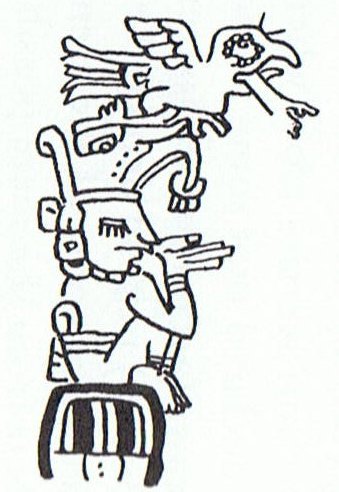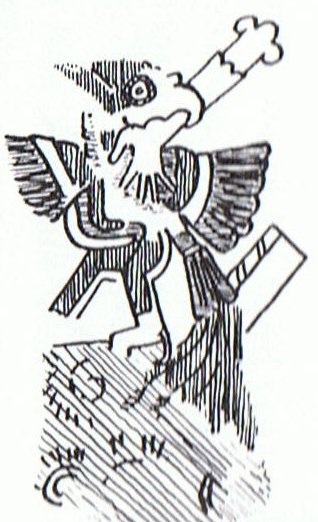|
TRANSLATIONS
Macaw - or at least Seven-Macaw (Itzam Yeh) - is, though, not the moon, he is the Big Dipper: ... in the time before the sky was lifted up to make room for the light, the vainglorious Seven-Macaw imagined himself to be the sun. Offended by his pride, the Hero Twins humbled him by breaking his beautiful shining tooth with a pellet from their blowgun ...
If we equate Macaw with 7-Macaw, then only 7 * 20 = 140 nights ought to be his. Or, even better, 145 nights, because of Alcor, which conceivably could represent Vayeb. Vayeb seems to be the location of Macaw in the picture below, because at bottom we recognize the central form of the glyph for Vayeb:
The location of Macaw is at the top, close to the center of the spinning wheel. In the beak he holds the arm of one of the Hero Twins, which he ripped off in the battle for supremacy. Next picture makes it even more clear:
We have 4 limbs, one for each quarter. Ripping away 1 of them, 7-Macaw took hold of one quarter, as I understand the picture language. The legs stand for the summer half of the year and the arms for the winter half. Presumably 7-Macaw took hold of the 4th and last quarter of the year, including Vayeb. In Aa1-15 it is a leg instead of an arm, maybe because the Big Dipper has shifted around half a turn, as seen from Easter Island:
The daughers of Amalivaca also 'lost' their legs (according to a myth in South America): ... Amalivaca, the ancestor of the Tamanac, arrived at the time of the great deluge in which all Indians, with the exception of one man and one woman who had taken refuge on the top of a mountain, had been drowned ... Amalivaca had daughters who were very fond of travel. So he broke their legs in order to force them to be sedentary ... In Métraux there is a story involving the same background theme (of an arm or leg being ripped off at the close of the year): "... A year passed. A priest called Uruarei of Tuu-tapu went on a hill and there he turned round performing magic rites to help the Tupahotu exterminate the Miru. He kept turning in a circle performing rites. One day, two Miru, Tema and Pauavaka, swam from Motu-nui and landed at Pu. They came up at Orongo and later descended into the crater. They saw ripe poporo fruits and ate them. When they were filled, they climbed up the slope to the edge of the crater and walked to Hanga-roa. They stopped at Pureva-nunui. There on the hill called Tuu-tapu, the priest Uruarei was turning round and round with the hope that the Miru would be exterminated. In the evening the priest went down to the hill Pureva-nunui where Tema and Pauavaka were concealed. He arrived at his house, but still he was turning around, sometimes in front of it, sometimes behind. He got dizzy and fell down. Tema and Pauavaka hit him with a digging stick. Uruarei, priest of Tupahotu, died. Tema cut off his leg and gave it to an old Miru woman who was the cook of Uruarei. Her name was Vai-ko-te-hukane. They ordered her to carry the leg. She carried it on her back and went to Vinapu, where she shouted to the people on the rocks, 'I am carrying the leg of Uruarei, killed by Tema and Pauavaka.' The people on the islets answered, 'How did the club-footed men succeed in landing?' ..." I guess the reason for ripping off an arm or leg at the top of the year only secondarily is to demonstrate how the dark 4th quarter is ending. The primary (original) reason was rather to adjust the number of limbs (arms or legs) in order to start with number 1 at the beginning of next year. Around summer solstice there will be 2 again.
|







